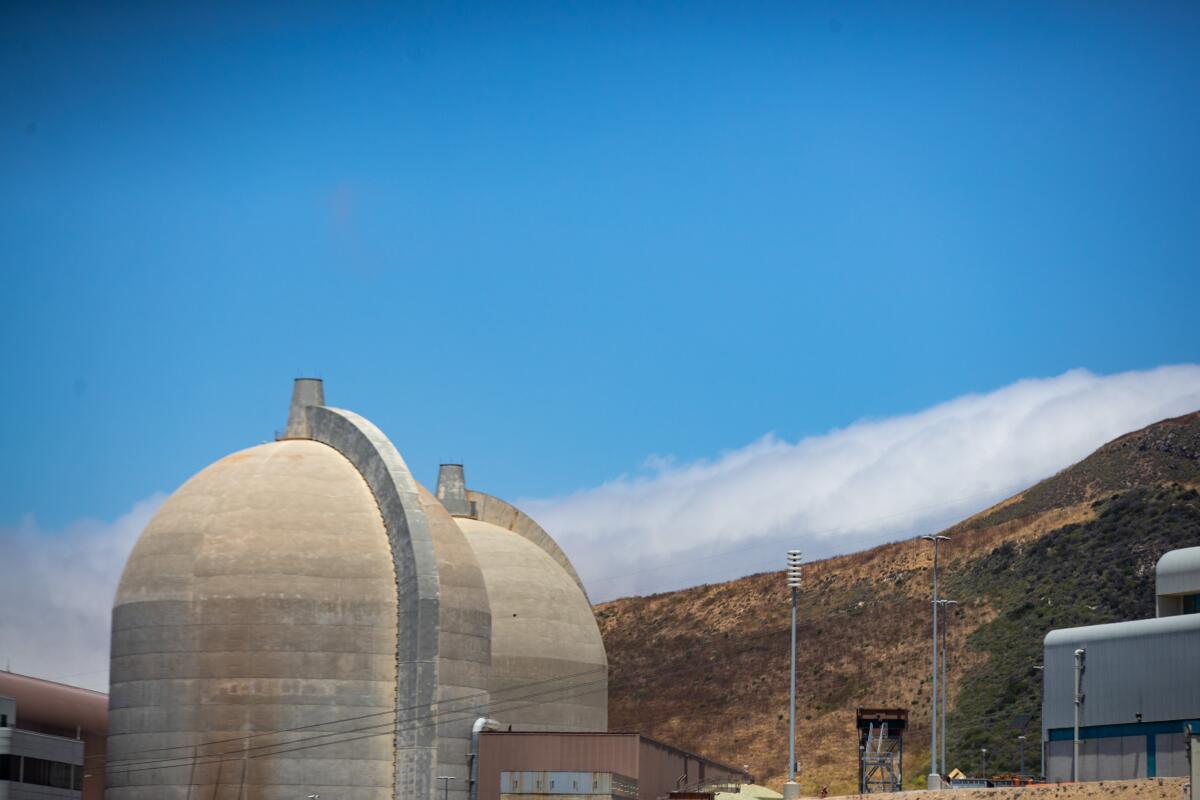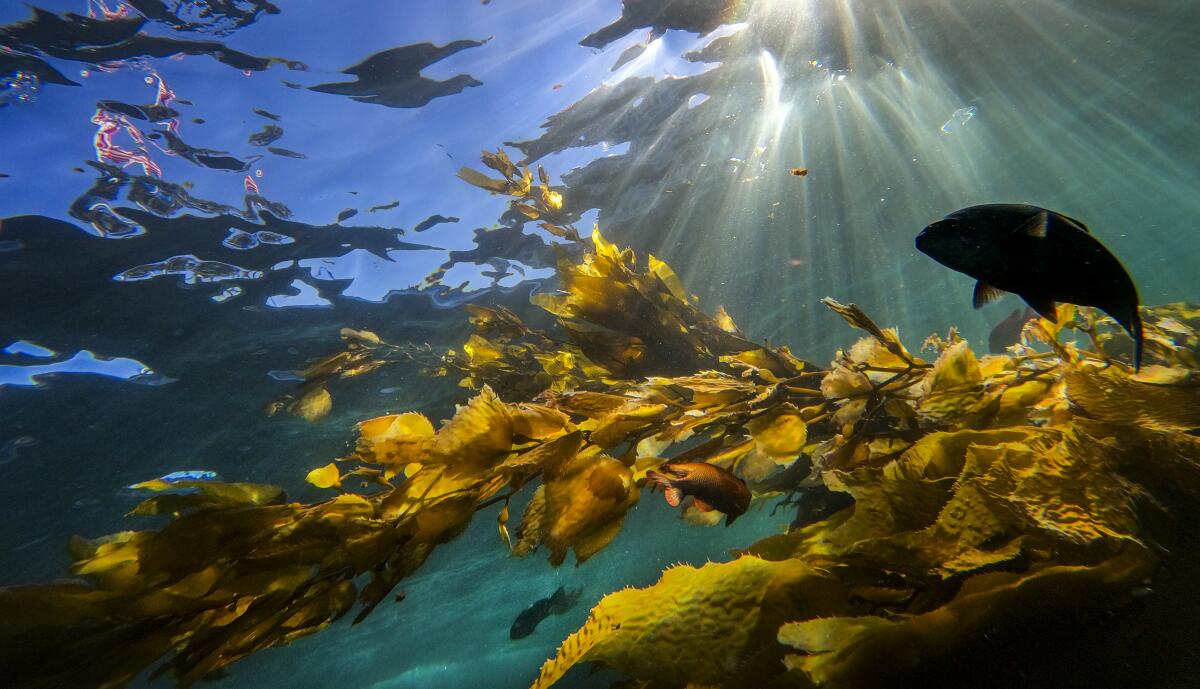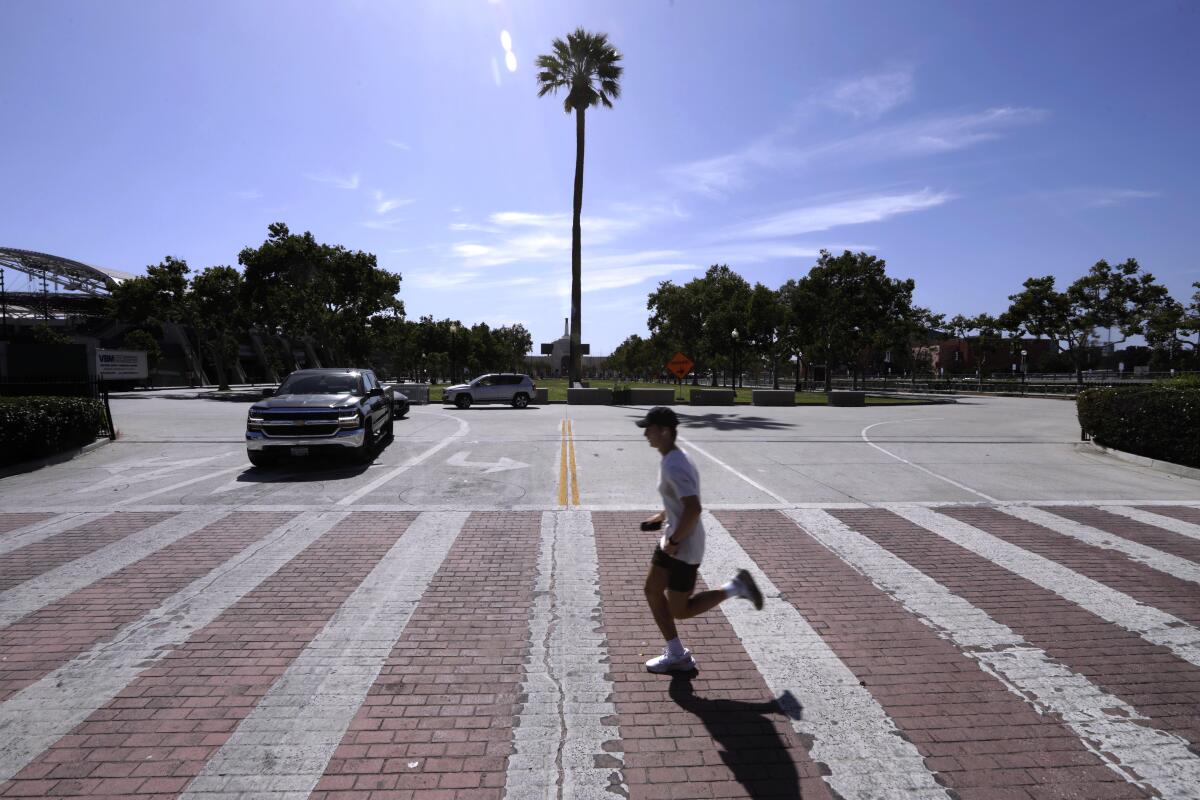If only nuclear power were an easy climate change solution

- Share via
What if solving the climate crisis were easy?
What if there were a single technology — or a single policy or lifestyle change — that could bring an end to deadlier heat waves, worsening wildfires, rising seas and more extreme droughts and storms? What if getting climate pollution under control were as simple as persuading politicians and the public to understand the immense value of that single, solitary solution?
You're reading Boiling Point
Sammy Roth gets you up to speed on climate change, energy and the environment. Sign up to get it in your inbox twice a week.
You may occasionally receive promotional content from the Los Angeles Times.
That’s what I was thinking as I read this story by the Wall Street Journal’s Jennifer Hiller, about Grace Stanke, the reigning Miss America, using her platform to promote nuclear power. Stanke is one of a growing number of Americans — I hear from them all the time — who see nuclear energy as the best way to confront global warming. If only Americans could get over their radiation and meltdown fears and support the construction of more reactors, they believe, it would be easy to stop burning fossil fuels.
Maybe they’re right. At least partially.
Maybe if everyone loved nuclear power, it would offer a faster, simpler path to 100% clean energy than the one the United States is on right now, which involves lots of solar panels and wind turbines and lithium-ion batteries. Maybe we wouldn’t have to worry so much about keeping the lights on after sundown, or killing birds with wind turbines, or mining lithium to build batteries.
But reality looks a lot different.
Many Americans worry about nuclear reactors melting down and spreading deadly radiation — a concern based on a handful of historical incidents. Whether or not you see that fear as valid, it exists. There’s also a long history of air and water contamination from the extraction and disposal of uranium fuel — including on tribal lands. It’s not hard to grasp why many politicians oppose new nuclear plants and have fought to shutter existing facilities. They’re listening to some of their most vocal constituents.
Yes, there’s been some change in public sentiment as the climate threat has become clearer. I doubt Gov. Gavin Newsom would be pushing to extend the life of California’s last nuclear plant, Diablo Canyon, if public opinion hadn’t begun to shift.
But as much as I wish that ending the combustion of fossil fuels were easy, that’s not the world we live in. Nuclear advocates can sing the technology’s virtues to the high heavens, but they’re not going to silence the critics or eliminate the drawbacks.
The same goes for every other climate solution pitched as a panacea.
If we’re serious about eliminating carbon emissions in the next 15 or 20 years, we can’t bank on any one solution, comforting as that might feel. Nuclear power, carbon pricing, pulling emissions out of the sky — they’re all potentially valuable tools, depending on how they’re implemented. But none of them are the be-all, end-all that their most ardent supporters want them to be.
Navigating the energy transition is going to be hard. It’s an unpleasant but important truth.
That’s why I’ve been traveling the American West, writing about local opposition to renewable energy development and how the opposing forces might learn to see eye to eye. It’s why I intend to use my new position as The Times’ first-ever climate columnist to continue writing about the challenges facing almost every clean energy option, from rooftop solar to offshore wind.
As always, feel free to reply to this email and let me know what you think.
**
It’s been two weeks since my last news roundup, so lots of stories to share. Here’s what’s happening around the West:
TOP STORIES

One of Sen. Dianne Feinstein’s most significant feats was protecting millions of acres in the California desert — including through the creation of Joshua Tree and Death Valley national parks. My L.A. Times colleague Louis Sahagún wrote about the groundbreaking conservation work undertaken by California’s longtime senator, who died on Friday. Feinstein was also a “general in California’s water wars,” as Politico’s Camille von Kaenel and Wes Venteicher describe her, often bucking her fellow Democrats to work with Republicans on policies that benefited Central Valley farmers at the expense of healthy rivers. I’ll be curious how Gov. Gavin Newsom’s choice to replace Feinstein in the U.S. Senate, Laphonza Butler, handles climate and environmental issues.
A new L.A. Times investigation reveals just how many rural water systems are failing across California, especially in low-income communities of color. Dangerous levels of arsenic, nitrates and other chemicals are in the drinking water being pumped to homes and schools, my colleagues determined. (If you want to find out whether your water is safe, you can look up your local utility here.) In other drinking water news, a new study predicts that thousands of wells could run dry in California’s Central Valley. It’s only the latest research identifying failings in the state’s landmark groundwater law, The Times’ Ian James reports.
Major home insurance companies have agreed to start offering policies again in California’s most fire-prone areas — in exchange for state officials agreeing to make it easier for them to raise rates. The Times’ Sam Dean has the details. Looking ahead to the rest of 2023, the odds are decent that California won’t experience the most devastating of fires this year. But all the rain-fueled growth from last winter could mean the state is primed to burn next year, experts tell my colleague Hayley Smith. And in other less-than-encouraging news, the temporary pay increase for federal firefighters approved by Congress in 2021 is on the verge of expiring — and House Republicans don’t seem inclined to permanently raise salaries, Alex Wigglesworth reports.
A startling new study led by Stanford University researchers finds that since 2016, wildfire smoke has slowed down air-quality progress in 30 states and reversed progress in 11 others. The worsening air pollution has been especially bad in the West, per the Washington Post’s Joshua Partlow. In Southern California, meanwhile, hundreds of warehouses aren’t complying with a rule designed to reduce harmful air pollution from truck traffic — and regulators say they’re finally ready to fine facilities that don’t start complying, The Times’ Tony Briscoe writes. If you’re wondering why Southern California’s air quality has stayed this bad for this long, my colleague Patt Morrison has a fascinating history of smog pollution in the Los Angeles Basin.
POLITICAL CLIMATE
“Big Oil is right to be concerned, for if even one [lawsuit] crosses the judicial finish line, the path could be cleared for a massive financial reckoning in which the industry is forced to pony up.” So writes L.A. Times columnist Michael Hiltzik, in a piece about California becoming the latest state to sue oil companies over their history of carbon emissions and climate denial. Gov. Newsom, meanwhile, says he’ll sign a bill requiring large corporations to disclose their emissions — but as Politico’s Blanca Begert and Alexander Nieves note, both Newsom and the California Chamber of Commerce have suggested the bill needs to be “cleaned up.” We’ll have to wait and see whether the governor asks lawmakers for business-friendly changes next year.
The top contributor to politicians seeking state office in California during the first half of this year was Sempra Energy, parent company of Southern California Gas Co. The Sacramento Bee’s Ari Plachta has the numbers. And while Sempra is still seeking support from state lawmakers for priorities including hydrogen and carbon capture, the San Diego-based company just won federal approval to expand a natural gas export terminal on Texas’ Gulf Coast, per Rob Nikolewski at the San Diego Union-Tribune. In other fossil fuel industry news, the Wall Street Journal’s Christopher M. Matthews and Collin Eaton got their hands on a treasure trove of internal documents showing how oil giant Exxon Mobil tried to downplay the severity of the climate crisis under then-Chief Executive Rex Tillerson, even as the company publicly supported the landmark Paris climate agreement.
U.S. Rep. Raul Ruiz has introduced a bill that would establish Chuckwalla National Monument, protecting 660,000 acres of California desert. Conservation activists, aware that the bill is unlikely to pass the Republican-controlled House, are urging President Biden to establish the monument, the Desert Sun’s Erin Rode reports. Elsewhere in the Golden State, Interior Secretary Deb Haaland visited Berryessa Snow Mountain National Monument, which tribes and conservationists want Biden to expand. And along the state’s Central Coast, members of the Chumash tribe are frustrated that marine sanctuary boundaries proposed by the Biden administration would allow for offshore wind development. Details here from Lucy Sherriff for the Guardian.
Eight years after my colleague Ian James first revealed that Nestlé was siphoning water from a national forest and selling it as bottled water, California officials have ruled that much of that water must remain in the forest. Here’s Ian’s story. “I’m hoping that we can see Strawberry Creek flow again, the springs back to their natural state, and the forest ecosystem return to what it was before the diversions,” one activist said. In other water news, two bills that would have given California more power to curtail water use by farmers during drought failed to make it out of the Legislature, CalMatters columnist Dan Walters writes.
WATER IN THE WEST

As our oceans heat up, scientists are building models to learn how fish and ecosystems may be faring deep beneath the surface. Some of what they’re learning is bad — but not all of it, The Times’ Susanne Rust writes. With air and water temperatures rising, it’s also getting harder to predict what the ongoing El Niño climate pattern will mean for rainfall. “Every weather event has some climate change DNA in it these days,” one meteorologist told my colleague Hayley Smith. Hayley also explored a Southern California water district testing out a new kind of seawater desalination, using the ocean’s natural water pressure to purify water down on the seafloor. It’s a technique that could be less environmentally damaging than traditional desal, supporters say.
Watchdog groups and a government whistleblower allege that a former nuclear research site just outside Los Angeles is probably leaking “forever chemicals” and toxic PCBs into the L.A. River. Here’s the story from Tom Perkins, for the Guardian — and if this all sounds familiar, it may be because I’ve written previously about Santa Susana Field Laboratory, in the Simi Hills west of the San Fernando Valley. In other news for folks who care about L.A.-area waterways, environmentalists are mourning the loss of Mark Abramson, who died last month at age 56. Abramson spent his life working to protect local creeks, watersheds and wildlife crossings, playing an especially important role in cleaning up Malibu Creek, as Haley Smith writes in The Times’ obituary.
Nearly 30 years after California last updated its water quality plan for most of the San Francisco Bay Delta, the state has proposed a bunch of competing, controversial ideas that are still years from being implemented — and probably litigated too. If you’re wondering what’s at stake and why crafting rules has taken so long, CalMatters’ Rachel Becker breaks it down.
As the Jewish harvest festival of Sukkot continues this week, a San Joaquin Valley farmer is helping Jews across the U.S. celebrate by growing etrogim — an unusual yellow fruit that represents the heart. The Times’ Daniel Miller wrote a fabulous story about the Presbyterian grower who has made this his mission, taking over the farm from his recently departed father and weathering intense storms that nearly wiped out his crop. Elsewhere in agricultural country, the Associated Press’ Amy Taxin took a look at the groundwater battle playing out between big growers and small farmers in California’s carrot-growing heartland.
THE ENERGY TRANSITION
Not long ago, real estate developers thought electric car chargers were a waste of money. But they’re now realizing how much demand there is for charging at stores, offices and apartment buildings, my colleague Roger Vincent reports. Drivers are motivated in part by gasoline prices, which have been super high lately. It’s still not totally clear why — California’s new oil czar said recently that a single, isolated trade on California’s gasoline “spot market” caused a 50-cent-per-gallon price spike, per the Sacramento Bee’s Maya Miller and Ari Plachta. If you’re looking to ditch freeways altogether, you’ll probably enjoy learning about a proposal to replace the 90 Freeway with green space and affordable housing. Details here from The Times’ Salvador Hernandez.
The California Public Utilities Commission is poised to deal a significant blow to Pacific Gas & Electric’s plan to bury 10,000 miles of power lines to prevent wildfire ignitions. Commission staff see the first stage of the plan, proposed by Chief Executive Patti Poppe, as unduly expensive for PG&E customers, the Wall Street Journal’s Katherine Blunt reports. In other news, Poppe has been defending PG&E’s membership in the American Gas Assn., an industry group that has faced criticism from climate activists. “Though we may not agree with every AGA policy position, we appreciate the opportunity to engage with our industry peers in these conversations,” Poppe wrote in an email to one customer obtained by journalist Emily Atkin for her Heated newsletter.
In big news for keeping the lights on when the sun isn’t shining and the wind isn’t blowing, the Biden administration has selected nine long-duration energy storage proposals for $325 million in funding. The goal is to prove out technologies that federal scientists believe have good odds of success, Canary Media’s Julian Spector reports. In the more immediate future, next week’s solar eclipse will be an interesting test for the Western electric grid, Kassia Micek writes for S&P Global. California officials are working to make sure we’ve got enough energy — including gas, hydropower and batteries — to weather the lack of sun.
Wyoming’s geology and energy infrastructure — and its Jackson Hole billionaires — could make the deep-red bastion one of the biggest beneficiaries of President Biden’s climate law. The New York Times’ Jeanna Smialek visited with the president of the Jackson Hole Center for Global Affairs, who’s trying to recruit wealthy locals to fund clean energy projects and take advantage of tax credits from the Inflation Reduction Act. Elsewhere in the West, journalist Ray Hagar wrote about the northern Nevada town of Winnemucca, which is an interesting case study on the pros and cons of new renewable energy infrastructure. Local residents are looking forward to hundreds of new jobs from a lithium mine, but they’ve got lots of concerns, including housing availability.
AROUND THE WEST

As temperatures rise, it’s becoming ever more important for Southern California cities to replace palm trees with trees that actually provide good shade. But that’s only happening haphazardly, my colleague Dorany Pineda reports. Meanwhile, in the Phoenix area — which is on track for a record number of heat-related deaths this year — Audrey Gray wrote a moving story for Mother Jones about the value of strong community as protection against extreme heat, as told from the perspective of a tiny Methodist church. There’s also a new poll showing that the worsening heat recently has made Americans more likely to realize that climate change is affecting their lives, per this story by the Associated Press’ Tammy Webber and Linley Sanders.
A conservation group wants to use sharpshooters in helicopters to kill 2,000 invasive mule deer on Catalina Island off the Southern California coast, to help restore natural ecosystems. But many local residents love the deer and are outraged, The Times’ Louis Sahagún writes. In other wildlife news, the Washington Post’s Dino Grandoni has a lovely story about scientists at Monterey Bay Aquarium raising sea otters and releasing them into the Pacific, where they can help restore carbon-sequestering kelp forests. And the AP’s Susan Montoya Bryan wrote about Bolson tortoises — America’s largest and rarest desert tortoises — being released on a New Mexico ranch owned by media mogul Ted Turner as part of an effort to help the species recover.
All sorts of classic TV shows and movies have been shot at Paramount Ranch in the Santa Monica Mountains. Now, after the Woolsey fire torched much of the ranch, the National Park Service has been left to decide which parts of the ranch to rebuild and which to let go, NPR’s Chloe Veltman reports. In the desert, meanwhile, the Guardian’s Gabrielle Canon reports that Joshua Tree National Park Service officials wanted to close the park during the last government shutdown in 2019, as the area suffered ecological damage in the absence of key staff. But a Trump administration official ordered Joshua Tree to stay open.
The Biden administration has agreed to give Pacific Northwest tribes $200 million to help fund their plan to reintroduce salmon in the Upper Columbia River Basin. The next big debate is whether four dams on the Lower Snake River, a tributary of the Columbia, should be torn down, Oregon Public Broadcasting’s Tony Schick reports. For more on the future of salmon in the Pacific Northwest — and the role of hydropower dams in the energy transition — see my recent story, focused on the Snake. And for details on how long it takes federal officials to approve new licenses for existing hydropower dams — and what those delays might mean for efforts to fight climate change, including in California — see this story by Miranda Willson for E&E News.
ONE MORE THING
I had a great time the weekend before last visiting the “Living in a Wildlife Corridor” exhibit at Descanso Gardens in La Cañada Flintridge. Co-created by former Disney Imagineer Joe Rohde, the exhibit included gorgeous photography and artwork, a kid-friendly play area and an interactive map showing how Los Angeles-area waterways and wildlife corridors overlap.
The exhibit is now closed, unfortunately. But I’ll definitely return to Descanso Gardens. It’s a gorgeous, peaceful place.
We’ll be back in your inbox Thursday. To view this newsletter in your Web browser, click here. And for more climate and environment news, follow @Sammy_Roth on Twitter.
Toward a more sustainable California
Get Boiling Point, our newsletter exploring climate change, energy and the environment, and become part of the conversation — and the solution.
You may occasionally receive promotional content from the Los Angeles Times.




